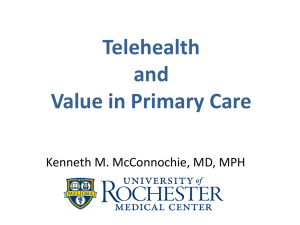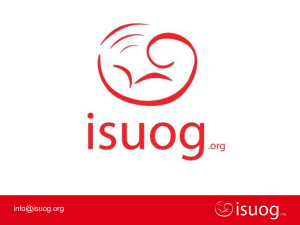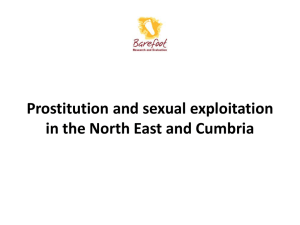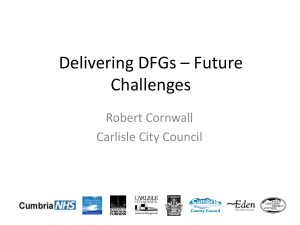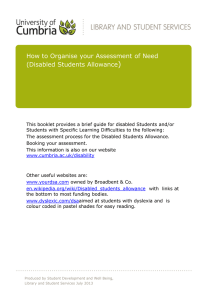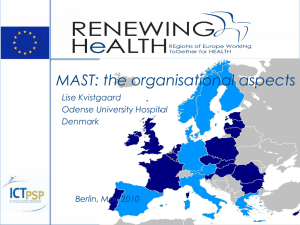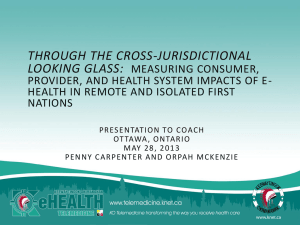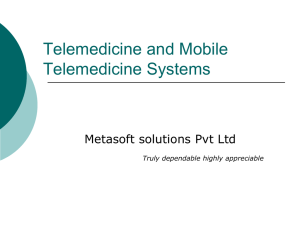from November workshop
advertisement
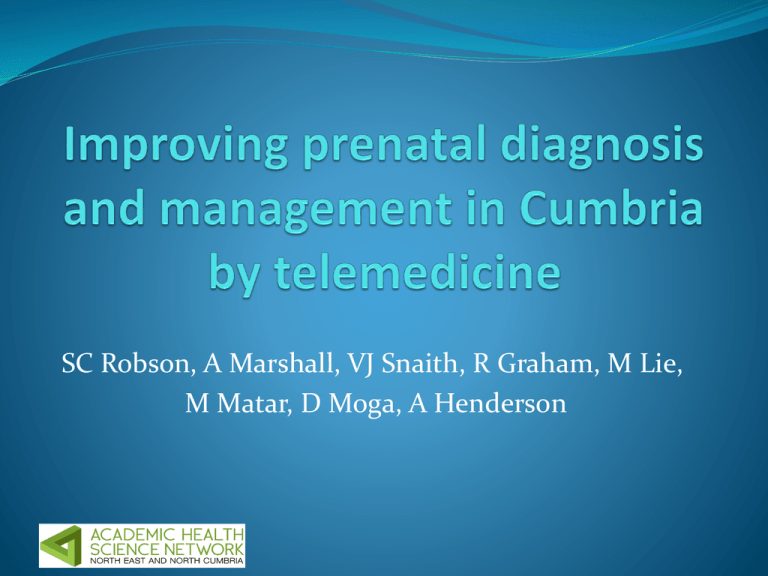
SC Robson, A Marshall, VJ Snaith, R Graham, M Lie, M Matar, D Moga, A Henderson Background to project Key component of antenatal care is to identify the ‘at risk’ fetus. Women referred by sonographer to local specialist or FMU when problem identified during scan. Specialist fetal medicine services concentrated in regional fetal medicine centres. Telemedicine has the potential to provide specialist obstetric ultrasound and specialist consultation to women distant from specialised centres (e.g. Cumbria). The technology can be used to provide on-site training for local sonographers in ‘advanced’ ultrasound investigations (e.g. fetal and maternal Doppler). Evidence of effectiveness Previous UK studies have shown that successful transmission of high quality ultrasound with live guidance, followed by counselling by videoconferencing is achievable in the majority of cases [1,2]. Even with smaller sized internet connections than now available, image quality was sufficient for diagnosis in >95% of cases [1]. The use of telemedicine was highly acceptable to patients with women expressing a preference for telemedicine consultation compared to face-to-face [2]. [1] Fisk NM et al. BJOG 1996; 103: 1092-5; [2] McCrossan BA et al. Prenat Diagn 2012, 12: 883-7. Innovation NUTH has invested in state-of-art videoconferencing facilities, currently there is no telemedicine service between Cumbria and Newcastle. Despite clear evidence of the effectiveness of the technology, a fetal telemedicine service has not been developed in the UK outside of small projects. Opportunities to dramatically alter the way FM services are offered throughout Cumbria and improve care. Mechanism for providing specialised obstetric ultrasound services and upskilling sonographers. Successful implementation of the technology should be seen as ‘proof of principle’ and wider use of the innovation in other clinical areas would follow. Project aims To establish a videoconferencing infrastructure between the obstetric ultrasound unit at West Cumberland Hospital and the Fetal Medicine Unit in Newcastle. To determine the technical success of the service. To evaluate the success of utilising the telemedicine technology for training sonographers To assess women’s views of using a telemedicine ultrasound service, including family costs. To assess the benefits and barriers to adoption of the service across Cumbria. Partnership working This project brings together health professionals and academics from all 4 partner organisations with relevant expertise, many of whom have worked together on prior projects. Strong clinical and teaching/training links already exist between the obstetric departments at NCUH and NUTH with established referral pathways for complex fetal problems. The project will further develop these clinical and academic links. Collaboration Prof S. Robson, Professor of Fetal Medicine, Newcastle University Dr R Graham, Senior Lecturer, School of Sociology, Newcastle University Dr M. Lie, Research Associate, Newcastle University Prof A Marshall, Professor of Health Technology & Innovation, University of Cumbria Mr M Matar, Clinical Director, North Cumbria University Hospitals NHS Trust Mr D Moga, Consultant Obstetrician, North Cumbria University Hospitals NHS Trust Mrs A Henderson, Lead Obstetric Sonographer, North Cumbria University Hospitals NHS Trust Dr V. Snaith – Senior Research Midwife/Sonographer, The Newcastle upon Tyne Hospitals NHS Foundation Trust Mr R. Beckwith, Data and Telecoms Manager, The Newcastle upon Tyne Hospitals NHS Foundation Trust Potential impact of project Reduction in the number of women required to travel to Newcastle for specialist fetal ultrasound. Reduction in associated family costs. Improved prenatal diagnosis and management of high risk fetuses by increasing access to specialist fetal medicine care. Enhanced standard of local obstetric ultrasound by developing local sonographers through telemedicine training. Evidence that a fetal telemedicine service is acceptable to parents and to health professionals Engagement of key local stakeholders and provision of robust evidence as to how the fetal telemedicine service can be implemented across a wider geography and potentially across additional clinical areas. Evaluation of telemedicine service Number of telemedicine consultations (together with indications) as a proportion of all FM cases / consultations referred from WCH. Technical success of every new consultation - success will be defined as an ultrasound image quality sufficient to make a definitive prenatal diagnosis. Cost impact - cost components for the NHS including consultation times and staff utilisation. Patient Evaluation All women who have had a telemedicine scan will be asked to complete a questionnaire to assess their views, acceptability and family costs. Sub-sample of women (n=10-15) will be asked to take part in a telephone interview to gain greater insight. Sonographer training Training of local sonographers will be undertaken at WCH during 20 week anomaly scans (for uterine artery Doppler) and fetal growth scan (for middle cerebral artery Doppler). After an initial tutorial (via videoconference) and assessment of baseline skills, supervised training will be undertaken. Sonographers will be deemed competent when five successful Objective Structured Assessments of Training (OSATs) are completed for each technique. Stakeholders • Information on the benefits and barriers to adoption of the service collected by using The Stakeholder Empowered Adoption Model, by identifying and contacting key decision makers. • Stakeholder interviews (face-to-face and telephone) • Determine how they are influenced by other stakeholders and what evidence they would like to see from the evaluative implementation. • Ensure a decision can be made at the end of the project. Project timeline 2014 July Aug Sept 2015 Oct N D J F Project set up Sonographer training Telemedicine consultations Evaluation questionnaires Evaluation Interviews Write up, assimilation and feedback Project suspended Mar Apr May Jun Jul Aug Sept Oct Progress Audit of fetal medicine referrals to determine the incidence and indication for referral Referral plan has been devised, detailing which cases are suitable for telemedicine service and the timeframe for increasing the complexity of cases. Training – following consultation to determine sonographer training needs, sonographer training programme has been developed including a training manual and OSATS. Regular project management group meetings Patients – The patient evaluation questionnaires and interview topic guide have been designed and a favourable opinion has been given by LREC. The patient questionnaire has been piloted for face validity with service users. Stakeholder interviews - contact with NHS managers (West Cumberland and Morecombe Bay), clinical staff (sonographers and obstetricians), and contacts within Cumbria CCG. Challenges Initial failure to establish a videoconferencing link between to RVI and WCH. Options explored: Direct Internet Access, N3, HIX Communication with senior managers at NCUH Trust Ongoing strategy NUTH Radiology Directorate plan to establish a videoconferencing link between the RVI and WCH to enable delivery of the Breast Screening service by March 2015 Two 100Mbp/s Trust links are being installed, a VC call at most is 1Mbp/s. More than sufficient bandwidth to utilise this link without compromising Breast Screening clinical service. Implementation of project delayed until March 2015 Continued engagement with senior managers at NCUH Thank you for listening Project funded by: AHSN North East and North Cumbria Contact: vikki.snaith@ncl.ac.uk
